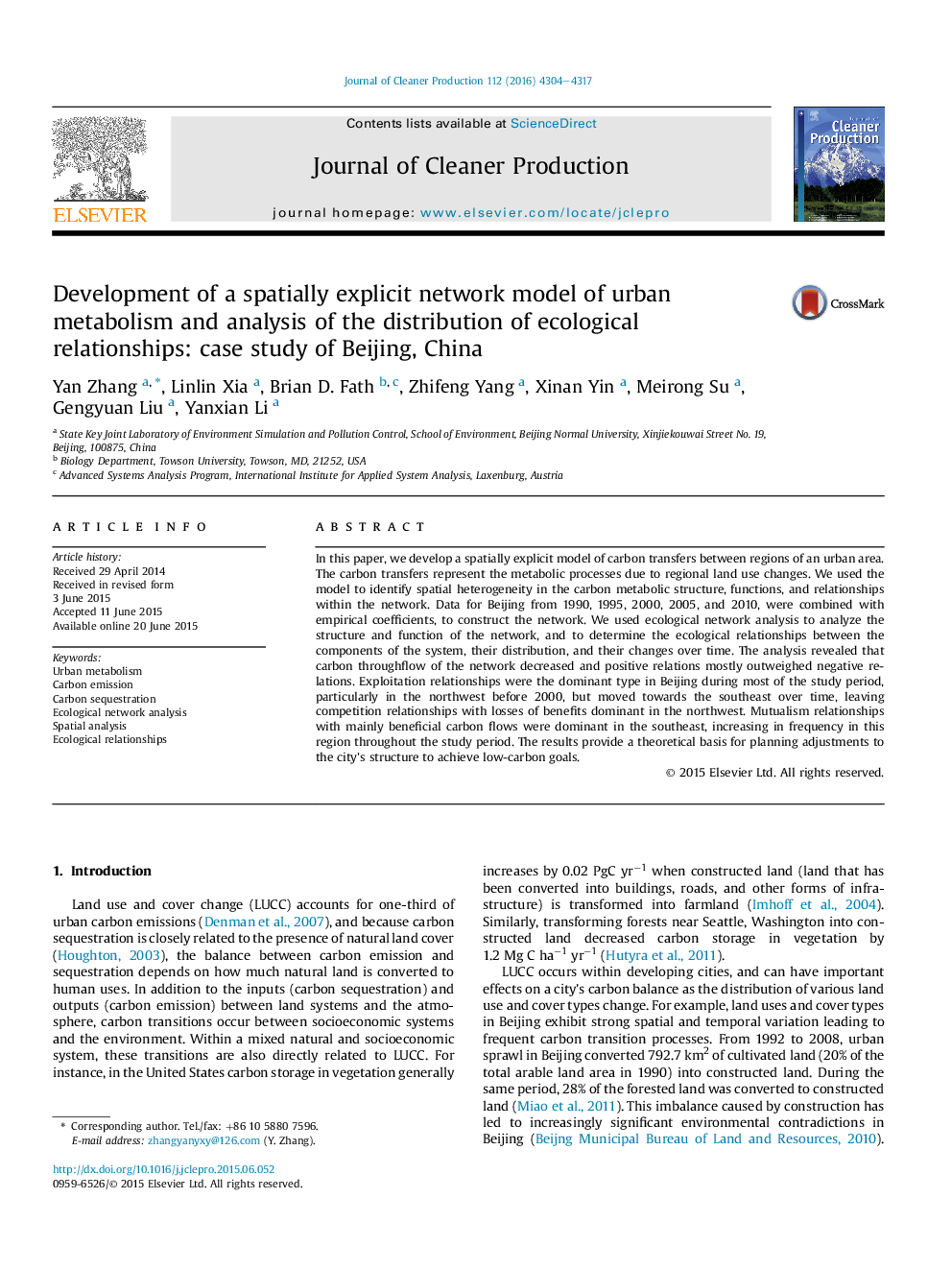| کد مقاله | کد نشریه | سال انتشار | مقاله انگلیسی | نسخه تمام متن |
|---|---|---|---|---|
| 10687973 | 1017969 | 2016 | 14 صفحه PDF | دانلود رایگان |
عنوان انگلیسی مقاله ISI
Development of a spatially explicit network model of urban metabolism and analysis of the distribution of ecological relationships: case study of Beijing, China
ترجمه فارسی عنوان
توسعه یک مدل شبکه صریح شبکه متابولیسم شهری و تجزیه و تحلیل توزیع روابط زیست محیطی: مطالعه موردی پکن، چین
دانلود مقاله + سفارش ترجمه
دانلود مقاله ISI انگلیسی
رایگان برای ایرانیان
کلمات کلیدی
متابولیسم شهری، انتشار کربن، تداخل کربن، تجزیه و تحلیل شبکه محیط زیست، تجزیه و تحلیل فضایی، روابط زیست محیطی،
ترجمه چکیده
در این مقاله، ما یک مدل صریح مکانی انتقال کربن بین مناطق منطقه شهری را توسعه می دهیم. انتقال کربن به دلیل تغییرات استفاده از زمین های منطقه ای، فرایندهای متابولیکی را نشان می دهد. ما از این مدل برای شناسایی ناهمگنی فضایی در ساختار متابولیک کربن، توابع و روابط درون شبکه استفاده کردیم. دادههای مربوط به پکن از سال 1990، 1995، 2000، 2005، و 2010 با ضرایب تجربی برای ساختن شبکه ترکیب شده است. ما از تجزیه و تحلیل شبکه های اکولوژیکی برای تجزیه و تحلیل ساختار و عملکرد شبکه استفاده کردیم و روابط محیطی بین اجزای سیستم، توزیع آنها و تغییرات آنها را در طول زمان تعیین کردیم. تجزیه و تحلیل نشان داد که جریان عبور کربن از شبکه کاهش می یابد و روابط مثبت بیشتر از روابط منفی بیش از حد است. روابط بهره برداری در پکن در طول دوره مطالعاتی، به ویژه در شمال غربی قبل از سال 2000، نوعی غالب در پکن بوده است، اما در طول زمان به سمت جنوب شرق حرکت کرده و روابط رقابتی با تلفات مزایای غالب در شمال غربی را ترک می کند. روابط متقابل با جریانهای کربن عمدتا سودمند در جنوب شرقی غالب بوده است و در طول دوره مطالعه در این منطقه افزایش یافته است. نتایج به دست آوردن مبنای نظری برای برنامه ریزی تغییرات در ساختار شهر برای دستیابی به اهداف کم کربن است.
موضوعات مرتبط
مهندسی و علوم پایه
مهندسی انرژی
انرژی های تجدید پذیر، توسعه پایدار و محیط زیست
چکیده انگلیسی
In this paper, we develop a spatially explicit model of carbon transfers between regions of an urban area. The carbon transfers represent the metabolic processes due to regional land use changes. We used the model to identify spatial heterogeneity in the carbon metabolic structure, functions, and relationships within the network. Data for Beijing from 1990, 1995, 2000, 2005, and 2010, were combined with empirical coefficients, to construct the network. We used ecological network analysis to analyze the structure and function of the network, and to determine the ecological relationships between the components of the system, their distribution, and their changes over time. The analysis revealed that carbon throughflow of the network decreased and positive relations mostly outweighed negative relations. Exploitation relationships were the dominant type in Beijing during most of the study period, particularly in the northwest before 2000, but moved towards the southeast over time, leaving competition relationships with losses of benefits dominant in the northwest. Mutualism relationships with mainly beneficial carbon flows were dominant in the southeast, increasing in frequency in this region throughout the study period. The results provide a theoretical basis for planning adjustments to the city's structure to achieve low-carbon goals.
ناشر
Database: Elsevier - ScienceDirect (ساینس دایرکت)
Journal: Journal of Cleaner Production - Volume 112, Part 5, 20 January 2016, Pages 4304-4317
Journal: Journal of Cleaner Production - Volume 112, Part 5, 20 January 2016, Pages 4304-4317
نویسندگان
Yan Zhang, Linlin Xia, Brian D. Fath, Zhifeng Yang, Xinan Yin, Meirong Su, Gengyuan Liu, Yanxian Li,
